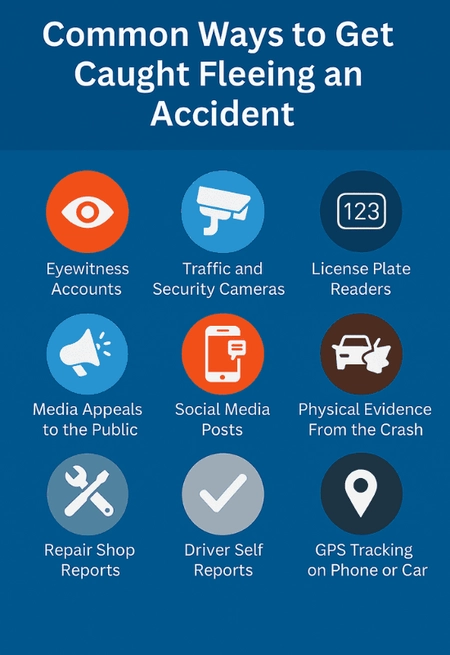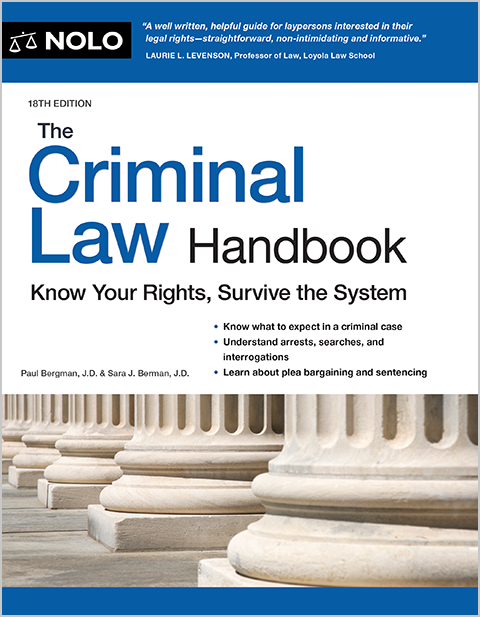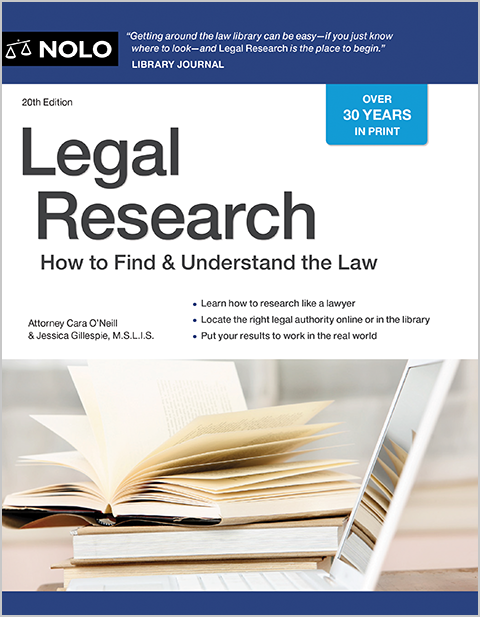It's never a good idea to flee the scene of a car accident. Here's why.
Getting into a car accident can spur some pretty primal human instincts: If we feel we've done something wrong, our first impulse could be to flee the scene. But here's what to know:
- Every state requires drivers to stop at the scene of a car accident as long as it's safe to do so.
- Fleeing the scene of a car accident can lead to criminal charges.
- Your driver's license will almost certainly be suspended or revoked if you commit a hit and run, and your car insurance policy might even be canceled.
- What Is a Hit-and-Run Car Accident?
- How a Hit-and-Run Accident Can Lead to Criminal Charges
- What Is a Hit-and-Run Offense Called in State Law?
- Defenses to Hit-and-Run Criminal Charges
- What Are the Penalties for a Hit-and-Run Offense?
- Will You Lose Your Driver's License for Leaving the Scene of an Accident?
- Are There Civil Penalties for a Hit and Run?
- How a Hit and Run Affects Car Insurance
- Getting Help After a Hit and Run
What Is a Hit-and-Run Car Accident?
Generally speaking, a hit and run occurs when you're involved in a car accident (either with a pedestrian, another car, or a fixed object) and then leave the scene without stopping to identify yourself or render aid to anyone who might need assistance. At least a few states also include in the definition of "hit and run" any collision with an animal.
In most states, it doesn't matter whether you caused the car accident or not. The act is committed simply by leaving the scene. If you must leave the scene of an accident to access emergency assistance—by leaving a rural cell phone "dead area" to get a signal, for example—most states do not consider that to be a hit and run, as long as you return immediately to the accident scene.
Most states do not require that the hit and run occur on a highway or public road. Many states extend hit-and-run laws to cover parking lot collisions. For example, if you back into an unoccupied car in a parking lot and fail to leave a note with your contact information on the windshield, the laws of many states treat this as a hit and run.
How a Hit-and-Run Accident Can Lead to Criminal Charges
State hit-and-run laws make it a crime for drivers to knowingly leave the scene of an accident without fulfilling certain legal duties. The purpose of these laws is to make sure victims receive needed assistance for injuries and can seek compensation for damages.


Criminal Charges for Fleeing the Scene of an Accident
To establish a hit-and-run charge, prosecutors must prove several elements in court. Typically, these elements consist of showing the driver was involved in an accident resulting in property damage or injuries and failed to:
- stop at the scene of the collision
- provide identification, and
- offer assistance to any person injured as a result of the accident.
These elements are fairly consistent among states, though the details sometimes differ.
Types of Accidents Requiring Drivers to Stop
Generally, drivers must stop and provide information when an accident involves property damage or injuries. So, if a driver hits a curb or something similar and there's no damage or injuries, the driver doesn't have to stop or do anything else.
Duty to Render Aid or Assist at the Scene of an Accident
Drivers who are involved in an accident resulting in injury or death must remain at the scene of the accident and provide reasonable assistance. In most instances, this means calling 911 to ask for law enforcement or medical assistance.
Information a Driver Must Provide Following an Accident
State laws differ somewhat on the specific information a driver must provide at the scene of an accident. However, in most states, drivers are required to provide at least some of the following:
- contact information (name, address, and phone number)
- contact information for the vehicle owner (if different)
- driver's license number and vehicle registration number, and
- insurance information.
Generally, drivers must provide this information to all others involved in the accident, including other motorists and pedestrians.
Driver's Responsibilities Where the Accident Involves an Unattended Vehicle or Property
Typically, drivers must make reasonable efforts to locate the owner of an unattended vehicle or property that is damaged in an accident. In most situations, leaving a note (that includes the information listed above) in a conspicuous and secure place will suffice. Some states require the driver to contact law enforcement with information.
What Is a Hit-and-Run Offense Called in State Law?
If you're looking for the hit-and-run law in your state, you might find it in the vehicle code or criminal code. Most states won't use the term "hit and run." Instead, this offense might be called something like:
- leaving or fleeing the scene of an accident (or collision) resulting in injury, death, or property damage
- duty to remain at the scene of an accident, provide information, and render aid, or
- duty to stop when involved in a motor vehicle accident.
Some states impose different duties depending on whether the accident causes injury to persons or property, so you might need to look at more than one statute to determine what duties and penalties apply.
Defenses to Hit-and-Run Criminal Charges
Hit-and-run laws generally require the driver to know that they were involved in an accident. A common defense to hit-and-run criminal charges is a lack of knowledge or intent on the defendant's part. If a driver thought they hit a pothole or an animal, these occurrences won't always trigger the duty to stop. Drivers must also know that a person was injured to trigger the duty to render aid. If a victim shows no signs of injuries, a driver would still need to provide their contact information but wouldn't have a duty to call an ambulance.
State laws might also state that the driver doesn't need to stay at the scene if: (1) they suffered injuries and are seeking help, or (2) they are taking a victim to the hospital. However, the driver must contact law enforcement to report the accident when they can.
The fact that a driver didn't cause the collision or accident won't typically relieve them of the duty to stop and assist. For instance, a court held that a driver who chased another car at high speeds but didn't hit the car was still "involved" in an accident, for purposes of the state's hit-and-run law, when the other car flipped over and the passengers were injured. (Evans v. Virginia, 82 Va.App 612 (2024).) It's also not a defense that the defendant didn't know they had a duty under the law to stop and assist.
What Are the Penalties for a Hit-and-Run Offense?
Some states provide stiff punishments for hit-and-run accidents, though specific penalties vary from state to state. In most places, prosecutors can charge the offense as either a felony or a misdemeanor, depending on the facts of the case.
Felony vs. Misdemeanor Hit-and-Run Offenses
A collision that results in a death or serious injuries will typically lead to felony hit-and-run charges. In some states, even a hit-and-run accident that causes significant property damage can mean a felony charge.
Typically, if no one was injured in the collision, the charge will be a misdemeanor. Some states distinguish penalties based on collisions involving attended property versus unattended property.
State Examples of Hit-and-Run Penalties
Below are a few examples of state penalties for hit-and-run crimes.
Florida makes it a misdemeanor to fail to stop and give required information at the scene of a crash involving property damage. Failure to stop and render aid after a collision resulting in injuries or death carries felony penalties. (Fla. Stat. §§ 316.027, 316.061, 316.062 (2025).)
New Jersey imposes motor vehicle violations on drivers who leave the scene of an accident without stopping to render aid or provide information. The motor vehicle violations carry the possibility of jail time and fines, with the harshest penalties applying to accidents resulting in injuries. The state also imposes criminal penalties of 5 to 10 years of prison time for knowingly fleeing an accident resulting in someone's death. (N.J. Stat. §§ 2C:11-5.1; 39:4-129 (2025).)
Pennsylvania makes it a felony in the second or third degree to leave the scene of an accident without stopping to provide aid or information. The law imposes mandatory minimum imprisonment terms of 90 days if the victim suffers serious bodily harm and 3 years in cases of death. Misdemeanor penalties apply when the accident involves property damage or bodily injury. (75 Pa.C.S. §§ 3742, 3743, 3744 (2025).)
Texas makes it a felony offense to leave the scene of a collision resulting in personal injury or death without providing contact information and rendering aid to injured persons. The harshest penalties apply when a collision results in another's death or serious bodily injury. Failure to stop and provide information after a collision resulting in property damage carries misdemeanor penalties. (Tex. Transp. Code §§ 550.021 to 550.025 (2025).)
Will You Lose Your Driver's License for Leaving the Scene of an Accident?
In addition to the criminal penalties for hit and run, almost every state imposes administrative penalties related to your driver's license. These penalties are often imposed through the individual state's Department of Motor Vehicles.
Any conviction for hit and run, regardless of whether it's for a felony or misdemeanor, typically results in an automatic suspension or revocation of your driver's license for a period of six months or so. In some states, the revocation can be as long as three years. Depending on the state in which you live, and the nature and circumstances of the car accident in which you were involved, the penalty for hit and run may include a lifetime revocation of your driver's license. These administrative penalties are in addition to any criminal punishment that might be imposed for hit and run.
Are There Civil Penalties for a Hit and Run?
If you have caused the accident, it is possible that another person involved in the crash may sue you in court for the damages they suffered. Such a lawsuit may ask for monetary compensation for medical bills, lost wages, and property damage.
Of course, this kind of lawsuit is likely to happen anyway even if you did not commit a hit and run at the scene of the accident, if you are deemed at fault for the car accident. But if you are liable for a hit and run on top of having caused the accident, the damages that a court orders you to pay will almost surely be increased. Some states will impose punitive damages or "treble damages" on a hit-and-run driver in a civil lawsuit.
Punitive damages are awarded in court to the injured person (the plaintiff), but they're not meant to cover the injured person's losses. Instead, they're meant to punish a defendant's particularly dangerous or outrageous behavior. A hit and run certainly might qualify. Learn more about punitive damages in car accident cases.
Treble damages awarded to the plaintiff are tripled where a statute requires or allows it. For example, if the jury in a civil suit awards the plaintiff $10,000 in damages, a statute related to civil penalties for hit and run might allow the judge to automatically triple that amount to $30,000 because the hit and run amounts to particularly reckless and egregious conduct.
In most instances, punitive and treble damages are not covered by your car insurance policy. In other words, you will have to pay that amount out of your own pocket.
How a Hit and Run Affects Car Insurance
In addition to the other penalties we've already touched on, many insurance companies have a practice of canceling your automobile insurance policy if you commit (or are convicted of) a hit and run.
Getting Help After a Hit and Run
If you've been arrested for a hit-and-run accident, the consequences can be severe. A qualified criminal defense attorney can let you know how the law applies in your case and whether you have any viable defenses. Having an experienced attorney at your side can make all the difference when you're facing serious criminal charges.
If someone hit you, you might want to start by reaching out to a car accident lawyer or personal injury lawyer in your area.
- What Is a Hit-and-Run Car Accident?
- How a Hit-and-Run Accident Can Lead to Criminal Charges
- What Is a Hit-and-Run Offense Called in State Law?
- Defenses to Hit-and-Run Criminal Charges
- What Are the Penalties for a Hit-and-Run Offense?
- Will You Lose Your Driver's License for Leaving the Scene of an Accident?
- Are There Civil Penalties for a Hit and Run?
- How a Hit and Run Affects Car Insurance
- Getting Help After a Hit and Run

